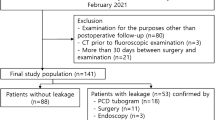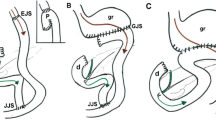Abstract
Postoperative leaks after gastrointestinal surgery are important to identify to decrease patient morbidity and mortality. Fluoroscopic studies are commonly employed to detect postoperative leak. While the literature addresses the sensitivity and specificity of these examinations, there is generally a lack of description of the fluoroscopic technique itself and there may be variability between radiologists in how these studies are performed. It is important to balance a standardized fluoroscopy protocol while tailoring the exam for each surgical and patient situation. Here we will briefly review common postoperative anatomy in the upper gastrointestinal tract, propose fluoroscopic techniques to improve postoperative leak detection, and illustrate teaching points with clinical cases.

Adapted from Flanagan, et al. [9] and used with permission. a Cervical esophagus resection site (star) and gastric resection site (green line). b Anastomosis may be cervical or intrathoracic. Cervical anastomosis (straight arrow); gastric resection site (arrowhead); pyloromyotomy (curved arrow). Pyloromyotomy is sometimes performed at time of esophagectomy to prevent potential complication of gastric outlet obstruction

Adapted from Levine et al. [10] and used with permission. Yellow arrow: small fundal pouch. Blue arrow: gastrojejunal anastomosis. Black arrow: Roux limb. Grey arrow: excluded stomach. White arrow: jejunojejunal anastomosis




source of the leak






Similar content being viewed by others
References
Belafsky PC, Kuhn MA (2014) The videofluoroscopic esophagram technique and protocol. In: Belafsky PC, Kuhn MA, editors.Clin Guid to Swallowing Fluoroscopy. New York, NY: Springer; p. 15–21. https://doi.org/10.1007/978-1-4939-1109-7_3
Biere SSAY, Maas KW, Cuesta MA, van der Peet DL (2011) Cervical or thoracic anastomosis after esophagectomy for cancer: a systematic review and meta-analysis. Dig Surg 28(1):29–35. https://www.ncbi.nlm.nih.gov/pubmed/21293129
Bingham J, Shawhan R, Parker R, Wigboldy J, Sohn V (2015) Computed tomography scan versus upper gastrointestinal fluoroscopy for diagnosis of staple line leak following bariatric surgery. Am J Surg 209(5):810–814. http://www.sciencedirect.com/science/article/pii/S0002961015000604
Buecker A, Wein BB, Neuerburg JM, Guenther RW (1997) Esophageal perforation: comparison of use of aqueous and barium-containing contrast media. Radiology 202(3):683–686. http://www.ncbi.nlm.nih.gov/pubmed/9051016
Carucci LR (2015) Postoperative stomach and duodenum. Textb gastrointest radiol. 4th ed. Philadelphia, PA: Elsevier/Saunders; p. 630–656https://www-clinicalkey-com.ezproxy.galter.northwestern.edu/#!/content/book/3-s2.0-B9781455751174000350?scrollTo=%23hl0000380
Ferreiro-Argüelles C, Jiménez-Juan L, Martínez-Salazar JM, et al. (2008) CT findings after laryngectomy. Radiogr A Rev Publ Radiol Soc North Am Inc 28(3):869–882; quiz 914. http://www.ncbi.nlm.nih.gov/pubmed/18480489
Goepfert RP, Hutcheson KA, Lewin JS, et al. (2017) Complications, hospital length of stay, and readmission after total laryngectomy. Cancer 123(10):1760–1767.
Sydow BD, Levine MS, Rubesin SE, Laufer I (2001) Radiographic findings and complications after surgical or endoscopic repair of zenker’s diverticulum in 16 patients. Am J Roentgenol 177(5):1067–1071. https://doi.org/10.2214/ajr.177.5.1771067
Flanagan JC, Batz R, Saboo SS, et al. (2016) Esophagectomy and gastric pull-through procedures: surgical techniques, imaging features, and potential complications. Radiogr A Rev Publ Radiol Soc North Am Inc 36(1):107–121. http://www.ncbi.nlm.nih.gov/pubmed/26761533
Levine MS, Carucci LR (2014) Imaging of bariatric surgery: normal anatomy and postoperative complications. Radiology 270(2):327–341.
Abou Rached A, Basile M, El Masri H (2014) Gastric leaks post sleeve gastrectomy: review of its prevention and management. World J Gastroenterol 20(38):13904–13910.
Houghton AD, Liepins P, Clarke S, Mason R (1996) Iso- or antiperistaltic anastomosis: does it matter? J R Coll Surg Edinb 41(3):148–151. https://europepmc.org/article/med/8763175. Accessed September 30, 2020
Tsao GJ, Damrose EJ (2010) Complications of esophagoscopy in an academic training program. Otolaryngol Neck Surg Off J Am Acad Otolaryngol Neck Surg 142(4):500–504. http://www.ncbi.nlm.nih.gov/pubmed/20304267
James AE, Montali RJ, Chaffee V, Strecker EP, Vessal K (1975) Barium or gastrografin: which contrast media for diagnosis of esophageal tears? Gastroenterology 68(5 Pt 1):1103–1113. http://www.ncbi.nlm.nih.gov/pubmed/1126592
Tanomkiat W, Galassi W (2000) Barium sulfate as contrast medium for evaluation of postoperative anastomotic leaks. Acta radiol 41(5):482–485. https://doi.org/10.1080/028418500127345730
Shucart WA, Almond CH, Cochran DQ (1961) Comparative study of the effects of various radiographic contrast media on the peritoneal cavity. Ann Surg 154(6):219–224. https://kopernio.com/viewer?doi=10.1097%2F00000658-196112000-00030&token=WzIxNDkyMDgsIjEwLjEwOTcvMDAwMDA2NTgtMTk2MTEyMDAwLTAwMDMwIl0.hmvBGBwVfa9SvTWP4_UAzO7kgbU
Caschera L, Lazzara A, Piergallini L, Ricci D, Tuscano B, Vanzulli A (2016) Contrast agents in diagnostic imaging: present and future. Pharmacol Res 110:65–75. https://doi.org/10.1016/j.phrs.2016.04.023. Accessed September 30, 2020
Tomaszek SC, Cassivi SD, Allen MS, et al. (2010) An alternative postoperative pathway reduces length of hospitalisation following oesophagectomy. Eur J Cardio-thoracic Surg 37(4):807–813.
Thomsen HS, Morcos SK, Erley CM, et al. (2008) The ACTIVE trial: comparison of the effects on renal function of iomeprol-400 and iodixanol-320 in patients with chronic kidney disease undergoing abdominal computed tomography. Invest Radiol 43(3):170–178.
Davenport MS, Asch D, Cavallo J, et al. ACR manual on contrast media. https://www.acr.org/-/media/ACR/files/clinical-resources/contrast_media.pdf. http://files/135/ACRContrast_Media.pdf
Swanson JO, Levine MS, Redfern RO, Rubesin SE (2003) Usefulness of high-density barium for detection of leaks after esophagogastrectomy, total gastrectomy, and total laryngectomy. Am J Roentgenol 181(2):415–420. www.ajronline.org. Accessed February 5, 2019
Terrazas M, Marjon L, Geter M, Schwartz J, Thompson W (2020) Esophagography and chest CT for detection of perforated esophagus: what factors influence accuracy? Abdom Radiol 45(10):2980–2988. https://doi.org/10.1007/s00261-019-02187-w. Accessed September 11, 2020
Funding
None.
Author information
Authors and Affiliations
Corresponding author
Ethics declarations
Conflict of interest
None.
Additional information
Publisher's Note
Springer Nature remains neutral with regard to jurisdictional claims in published maps and institutional affiliations.
Rights and permissions
About this article
Cite this article
Ross, S.L., Veluswamy, B., Craig, E.V. et al. Optimizing detection of postoperative leaks on upper gastrointestinal fluoroscopy: a step-by-step guide. Abdom Radiol 46, 3019–3032 (2021). https://doi.org/10.1007/s00261-021-02978-0
Received:
Revised:
Accepted:
Published:
Issue Date:
DOI: https://doi.org/10.1007/s00261-021-02978-0




